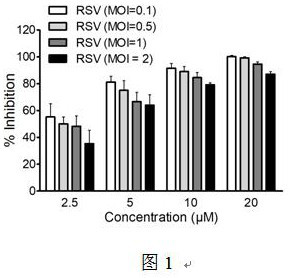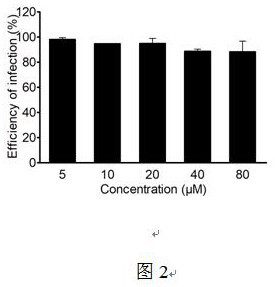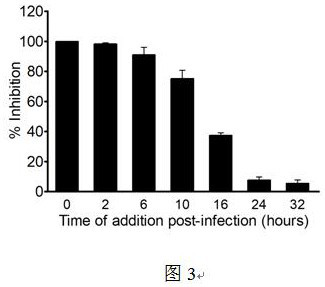Polycyclic benzodifuran compound and application thereof as anti-RSV drug
A polycyclic benzobisfuran compound technology, applied in the field of polycyclic benzobisfuran compounds, can solve the problems of teratogenicity, unsatisfactory application effect of anti-RSV drugs, general curative effect, etc.
- Summary
- Abstract
- Description
- Claims
- Application Information
AI Technical Summary
Problems solved by technology
Method used
Image
Examples
Embodiment 1
[0041] Embodiment 1: the preparation of compound 7~12
[0042]
[0043] first step:
[0044] Dissolve phloroglucinol 5 in nitromethane solution at room temperature, add anhydrous aluminum trichloride and isovaleryl chloride successively, and raise the temperature to 40 ºC. After reacting for 5 hours, the reaction solution was slowly poured into ice water, and saturated potassium sodium tartrate solution was added, followed by vigorous stirring. The reaction solution was extracted 3 times with ethyl acetate. The organic phases were combined and washed with saturated NaCl solution. After drying and filtering over anhydrous sodium sulfate, the organic phase was evaporated to dryness under reduced pressure. The resulting crude product was separated and purified by silica gel column chromatography to obtain compound 7 (90% yield)
[0045] Step two:
[0046] Compound 7 was dissolved in MeOH solution at room temperature, and NaOMe in MeOH solution was added. After reacting a...
Embodiment 2
[0055] Embodiment 2: the preparation of compound 15 and 16
[0056]
[0057] first step:
[0058] Dissolve phloroglucinol 5 in nitromethane solution at room temperature, add anhydrous aluminum trichloride and p-fluorophenylacetyl chloride 13 successively, and raise the temperature to 40 ºC. After reacting for 5 hours, the reaction solution was slowly poured into ice water, and saturated potassium sodium tartrate solution was added, followed by vigorous stirring. The reaction solution was extracted 3 times with ethyl acetate. The organic phases were combined and washed with saturated NaCl solution. After drying and filtering over anhydrous sodium sulfate, the organic phase was evaporated to dryness under reduced pressure. The obtained crude product was separated and purified by silica gel column chromatography to obtain compound 14 (yield 80%).
[0059] Step two:
[0060] At room temperature, compounds 10 and 14 were dissolved in toluene, then trifluoroacetic acid and m...
Embodiment 3
[0063] Embodiment 3: the preparation of compound 19 and 20
[0064]
[0065] first step:
[0066] Dissolve phloroglucinol 5 in nitromethane solution at room temperature, add anhydrous aluminum trichloride and cyclohexanecarbonyl chloride 17 successively, and raise the temperature to 40 ºC. After reacting for 5 hours, the reaction solution was slowly poured into ice water, and saturated potassium sodium tartrate solution was added, followed by vigorous stirring. The reaction solution was extracted 3 times with ethyl acetate. The organic phases were combined and washed with saturated NaCl solution. After drying and filtering over anhydrous sodium sulfate, the organic phase was evaporated to dryness under reduced pressure. The resulting crude product was separated and purified by silica gel column chromatography to obtain compound 18 (yield 75%).
[0067] Step two:
[0068] At room temperature, compounds 10 and 18 were dissolved in toluene, then trifluoroacetic acid and m...
PUM
 Login to View More
Login to View More Abstract
Description
Claims
Application Information
 Login to View More
Login to View More - R&D
- Intellectual Property
- Life Sciences
- Materials
- Tech Scout
- Unparalleled Data Quality
- Higher Quality Content
- 60% Fewer Hallucinations
Browse by: Latest US Patents, China's latest patents, Technical Efficacy Thesaurus, Application Domain, Technology Topic, Popular Technical Reports.
© 2025 PatSnap. All rights reserved.Legal|Privacy policy|Modern Slavery Act Transparency Statement|Sitemap|About US| Contact US: help@patsnap.com



